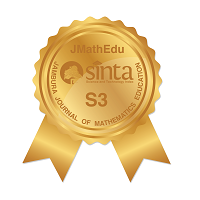Peran Media Pembelajaran Matematika sebagai Teknologi dan Solusi dalam Pendidikan Di Era Digitalisasi dan Disruption
Abstract
Technology makes a very important contribution to mathematics learning. The main requirement for successful integration of technology in learning mathematics is about willingness and commitment to adapt to change through learning design activities by preparing the right learning tools and resources, including media. This study aims to determine the effectiveness of integrating media in mathematics learning in Grade VII of SMP Negeri 11 Gorontalo. The method used is descriptive which examines the teacher's ability to manage learning, student learning activities, responses, and learning outcomes. Based on the descriptive analysis of the results of research on the effectiveness of mathematics learning media as educational technology at SMP Negeri 11 Gorontalo with indicators of the teacher's ability to manage learning, student learning activities, student responses and classical learning outcomes it can be concluded that the teacher's ability to manage learning is categorized as effective, student activity is categorized effective, student responses to learning activities is positive, and classically complete learning outcomes. Thus, the integration of media in learning mathematics in Grade VII of SMP Negeri 11 Gorontalo can be said to be effective.
Keywords
Full Text:
PDFReferences
D. S. Prawiradilaga, Mozaik teknologi pendidikan: E-learning. Jakarta: Kencana, 2016.
V. Crittenden and R. A. Peterson, "Digital disruption: The transdisciplinary future of marketing education" Journal of Marketing Education, vol. 41, no. 1, 2019.
N. Selwyn, "Discourses of digital "disruption" in education: a critical analysis" in: Fifth International Roundtable on Discourse Analysis, City University Hong Kong, 2013, pp. 1-28.
S. Gejendhiran, S. A. Anicia, and M. Kalaimani, "Disruptive technologies-a promising key for sustainable future education" Procedia Computer Science, vol. 172, pp. 843-847, 2020.
P. Lestari, et al., "Self-Determination and Technological Pedagogical Content Knowledge (TPACK): How Novice Teachers in Mathematics Education Surviving and Thriving in Disruption Era" Journal of Physics: Conference Series, vol. 1819, no. 1, pp. 012017, 2021.
F. Lubis, "Education in the disruption era"Britain International of Linguistics Arts and Education (BIoLAE) Journal, vol. 1, no.2, pp. 183-188, 2019.
Z. Taleb; A. Ahmadi, and M. Musavi, "The effect of m-learning on mathematics learning" Procedia-Social and Behavioral Sciences, vol. 171, pp. 83-89, 2015..
D. Persico and F. Pozzi, "Task, Team and Time to structure online collaboration in learning environments" World Journal on Educational Technology, vol 3, no. 1, pp. 1-15, 2011.
J. Young, "Technology-enhanced mathematics instruction: A second-order meta-analysis of 30 years of research" Educational Research Review, vol. 22, pp. 19-33, 2017.
N. Nurdyansyah and Q. Aini, "Peran Teknologi Pendidikan Pada Mata Pelajaran Matematika Kelas Iii Di Mi Ma'arif Pademonegoro Sukodono" At-Thullab: Jurnal Pendidikan Guru Madrasah Ibtidaiyah, vol. 1, no. 1, pp. 124-140, 2017.
A. Jupri, "Peran teknologi dalam pembelajaran matematika dengan pendekatan matematika realistic" in: Prosiding Seminar Nasional Matematika dan Pendidikan Matematika, 2018, pp. 303-314.
S. Putrawangsa and U. Hasanah, "Integrasi teknologi digital dalam pembelajaran di era industri 4.0" Jurnal Tatsqif, vol. 16, no. 1, pp. 42-54, 2018.
W. Widyawati, "Integrasi teknologi informasi dalam pembelajaran anak usia dini" Yaa bunayya, vol. 1, no. 1, pp. 16-28, 2021.
G. Y. Marthani and N. Ratu, "Media Pembelajaran Matematika Digital "BABADA" pada Materi Kesebangunan Bangun Datar" Mosharafa: Jurnal Pendidikan Matematika, vol. 11, no. 2, pp. 305-316, 2022.
R. Maskur, N. Nofrizal, and M. Syazali, "Pengembangan media pembelajaran matematika dengan Macromedia Flash" Al-Jabar: Jurnal Pendidikan Matematika, vol. 8, no. 2, pp. 177-186, 2017.
S. Mulyati and H. Evendi, "Pembelajaran matematika melalui media game quizizz untuk meningkatkan hasil belajar matematika SMP" GAUSS: Jurnal Pendidikan Matematika, vol. 3, no.1, pp. 64-73, 2020.
R. Rusdi and M. Fachruddin, "Efektifitas media pembelajaran matematika menggunakan software animasi berbasis multimedia interaktif model tutorial pada materi garis dan sudut untuk siswa SMP/Mts kelas VII"Jurnal Penelitian Pembelajaran Matematika Sekolah (JP2MS), vol. 1, no. 1, pp. 9-13, 2017.
L. Lutfiyah and D. N. Sulisawati, "Efektivitas Pembelajaran Matematika Menggunakan Media Berbasis E-Learning" Jurnal Pendidikan Matematika: Judika Education, vol. 2, no.1, pp: 58-65, 2019.
T. P. Wardani and F. E. Subekti, "Systematic Literature Review: Efektivitas Media Interaktif Dalam Pembelajaran Matematika" Jurnal Ilmiah Wahana Pendidikan, vol. 8, no. 11, pp. 394-403, 2022.
DOI: https://doi.org/10.34312/jmathedu.v4i1.17376
Refbacks
- There are currently no refbacks.
Copyright (c) 2023 Jambura Journal of Mathematics Education

This work is licensed under a Creative Commons Attribution-NonCommercial 4.0 International License.
Jambura Journal of Mathematics Education has been indexed by:
EDITORIAL OFFICE OF JAMBURA JOURNAL OF MATHEMATICS EDUCATION |
 | Department of Mathematics, Universitas Negeri Gorontalo Jl. Prof. Dr. Ing. B. J. Habibie, Moutong, Tilongkabila, Kabupaten Bone Bolango, Gorontalo 96554, Indonesia |
 | Email: [email protected] |
 | +6285255745923 (Call/SMS/WA) |
 | Jambura Journal of Mathematics Education (JMathEdu | eISSN: 2721-7477) by Department of Mathematics Universitas Negeri Gorontalo is licensed under a Creative Commons Attribution-NonCommercial 4.0 International License. Powered by Public Knowledge Project OJS. |



















